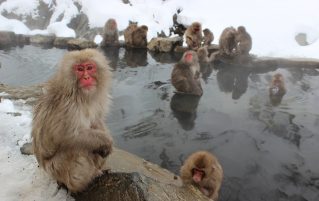Homeostasis is the regulation of conditions in the body, such as temperature. Unlike us, animals are not able to curl up under a blanket with a hot water bottle when it is cold. So how do they keep themselves warm?
Japanese snow macaques live far North where it snows a lot! While they have thick furry coats as do many animals living in colder climates, they have also found another way to keep warm. Just like humans, they enjoy a lovely warm bath. They will take a nice relaxing dip in mountainous hot springs. Research shows that not only does the hot water keep them warm, but it also relaxes them. Apparently, the females who take the longest baths are also the highest ranking.
Cold-blooded animals are not able to produce their own body heat. Therefore they have had to adapt in other ways in order to keep themselves warm. Some, like the notothen fish, actually produce antifreeze which travels in their blood. the proteins in the antifreeze bind to ice crystals, preventing them getting too big and damaging tissues. The wood frog actually freezes when it gets too cold. As it gets colder, water freezes on the frog’s body, forming a protective layer. Inside the frog, ice fills the abdominal cavity, and surrounds the internal organs. Large amounts of glucose and urea build up and enter every cell in the body, stopping them freezing. So, it actually allows ice to form outside all the cells and organs, but stops ice forming inside cells. The frozen frog is like a statue all winter, its heart does not even beat.
And for animals that really dislike the cold – migration is the only option. The great snipe is most keen to reach the warmth, travelling at speeds of up to 60mph for over 6,8ookm. The Bar-tailed Godwit has the record for the longest non- stop flight. The records show a flight of over 6 835 miles, without any food or sleep. Amazing!
To help you understand how we manage not to overheat in the hot weather, or freeze in the winter, have a look at Part 1 of our “How to” revision guide on Homeostasis. This guide explains the basics of homeostasis, and what we need to keep the same in the human body. This guide concentrates on thermoregulation:






